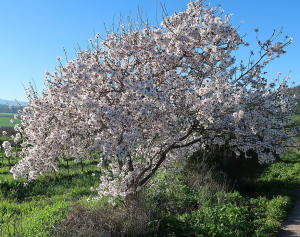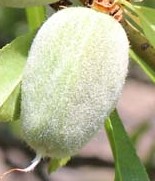 Almonds are deciduous trees native to the Middle East, Indian subcontinent and North Africa and are members of the rose family, Roseacea. They are in the same genus (Prunus) as plums, cherries, apricots, nectarines, and peaches but are most closely related to peaches. The upright trees grow 25-40′ tall, and have wide spreading branches and rough gray bark. The bright green leaves are simple and three to five inches long by 1 1/8-1 ¾ inches wide. The white to pale pink flowers are one to two inches across and have five petals. They appear singly or in pairs in spring before the leaves emerge and give way to oblong, brown fruits, 1 ½ inches long. Although commonly called a nut, botanically the fruit is a drupe, similar to the pit of a peach. Although there are two varieties of almond, bitter and sweet, the sweet ones are more commonly grown commercially for their fruit. They need hot summer temperatures, dry air, and wet winters to set good fruit and are widely grown in the Central Valley of California that accounts for over 75% of the world’s production. Trees begin bearing fruit at three years of age. In addition, almond trees are also very attractive garden plants when they bloom and are prized ornamentals. The genus name, Prunus, comes from the Greek word προύνη meaning plum, a prominent member of this genus. The genus name and specific epithet, amygdalus, is the ancient Latin name for almond and is no longer used as a genus name. The specific epithet, communis, is the Latin word meaning common or general.
Almonds are deciduous trees native to the Middle East, Indian subcontinent and North Africa and are members of the rose family, Roseacea. They are in the same genus (Prunus) as plums, cherries, apricots, nectarines, and peaches but are most closely related to peaches. The upright trees grow 25-40′ tall, and have wide spreading branches and rough gray bark. The bright green leaves are simple and three to five inches long by 1 1/8-1 ¾ inches wide. The white to pale pink flowers are one to two inches across and have five petals. They appear singly or in pairs in spring before the leaves emerge and give way to oblong, brown fruits, 1 ½ inches long. Although commonly called a nut, botanically the fruit is a drupe, similar to the pit of a peach. Although there are two varieties of almond, bitter and sweet, the sweet ones are more commonly grown commercially for their fruit. They need hot summer temperatures, dry air, and wet winters to set good fruit and are widely grown in the Central Valley of California that accounts for over 75% of the world’s production. Trees begin bearing fruit at three years of age. In addition, almond trees are also very attractive garden plants when they bloom and are prized ornamentals. The genus name, Prunus, comes from the Greek word προύνη meaning plum, a prominent member of this genus. The genus name and specific epithet, amygdalus, is the ancient Latin name for almond and is no longer used as a genus name. The specific epithet, communis, is the Latin word meaning common or general.
 Type: Deciduous flowering tree
Type: Deciduous flowering tree
Outstanding Feature: Flowers, fruit
Form: Oval canopy
Growth Rate: Moderate
Bloom: White to pale pink, five petaled flowers 1 ½ inches across in spring
Size: 25-40’ H x 20-25’ W
Light: Full sun
Soil: Fertile, deep, well-drained; does not tolerate alkali or salt.
Hardiness: Zones 6-9
Care: Prune to establish a framework with three main branches.
Pests and Diseases: Mites, peach twig borer, brown rot, shot-hot fungus, oak-root fungus
Propagation: Seed with cold stratification, cuttings, layering
Photo Credit Davidbena Wikipedia